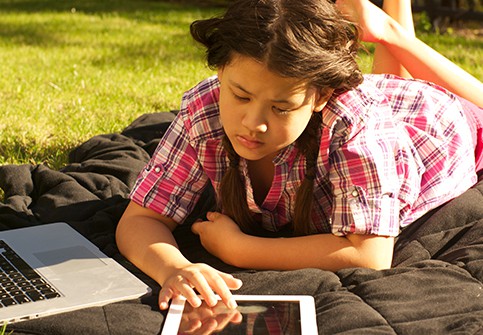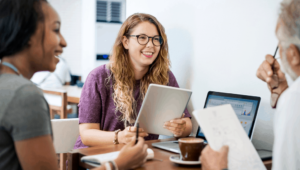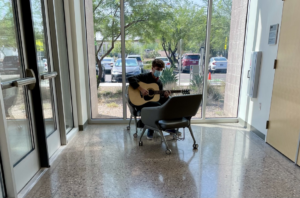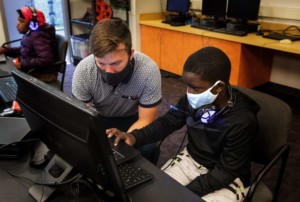What Personalized Learning Means in My Family

I wish school were different for my children. As a mom living in a school district with excellent schools, high test scores and property values, research-based practices, and warm, thoughtful educators who care about my kids you would think I would be satisfied. But like generations of parents before me, I want more for my kids than what I had. Though I went to great schools with caring educators and have led a prosperous life, if I am to be honest, for a time, I traded authenticity for success and led the rat-race life of the late 20th-century workaholic and in the end discovered the obvious: what matters to a good life, a happy life, (once a certain level of financial security is reached) is authentic, meaningful work and authentic, meaningful relationships.
So much of work is “fake” – meaningless make-work that doesn’t advance the interests of the company or its customers, meetings in which nothing is accomplished, insecure leaders who are subject matter experts but unskilled in collaboration, employees who are more concerned with how they appear than the substance of their work, and – politics.
So what would a school look like that prepared my children for meaningful, authentic work and meaningful relationships?
- School would respect the natural rhythms of learning – periods of intense immersion and periods of collaborative exploration and periods of original creation and contribution.
- School would include experiences where my kids genuinely struggle – with systems thinking, with ethical thinking, with problem-solving, with collaborative work, with designing and doing, with experimentation and iteration – all within the context of real work, the kind where the experience of “flow” is not only possible, but likely.
- School would engage my kids’ unique strengths and talents and give them the experience of success as well as an appreciation of failure.
- Because our world still rewards accreditation, school would prepare my kids for college should they choose to attend.
What could learning look like? How is our family promoting this kind of education at home?
As a family we have taken advantage of local and distant learning resources that allow us to treat education as a customized learning experience for each of our kids:
The Village Free School: VFS is a free and democratic school where students have a genuine decision-making role and where conflict resolution is a genuine priority – as evidenced by behaviors, not just ideals.
The Art of Problem Solving: This on-line community offers distance learning in math topics for students who are interested in competitive mathematics.
Florida Virtual School: FLVS has a program that allows students all over the world to take advantage of their world-class distance learning courses.
TED-Ed: Serendipity incarnate, the delightful short videos from TED-Ed provide food for thought on all kinds of topics it might never occur to us to explore otherwise.
World of Warcraft: Getting good at this game requires Internet research skills: search and keyword strategies, identifying reliable sources, applying and evaluating others’ strategies, poring through forum discussions to determine what is relevant. Second, participating in guilds and raid groups is startlingly similar to navigating professional groups: there are countless lessons in collaboration, group goal setting, developing collective standards of quality, managing personalities, establishing a voice and reputation, managing expectations, making commitments, and accepting responsibility – these aren’t the “managed” interactions that you get in team situations where there are adults supervising children, but rather the authentic interactions of people of all ages working together as peers.
Rosetta Stone: We have software for family language learning in Spanish, French and Mandarin.
In using these tools, we have done a number of things as a family:
- Identify the educational goals of our family and our children.
- Identify the best resources for achieving the traditional goal of being prepared for college.
- Identify opportunities to gain the non-traditional skills that public school may not support.
What do we still need to provide our kids real personalized learning?
Personalized can mean many different things. At this point our kids have been in Montessori, public school, private school, free and democratic school, homeschooled and unschooled according to what they needed most at any given time. That’s certainly a form of personalization, but each choice has implied trade-offs where we gave up something important in order to gain something which, at that time, was even more important.
- In elementary school, my kids had access to qualified, caring teachers who knew them as individuals and respected their unique abilities and who were unparalleled in helping them develop skills in areas where they struggled. However, these educators didn’t have the resources to help my kids truly develop their strengths. My mathematician son who lived for math learning before he started school had nearly learned to hate it by the time he entered middle school. My project-loving Maker daughter only learned about authentic projects and honest collaboration as part of the maker club we started together. And, as the unschoolers point out, no matter how warm their educators, the fundamental structures and assumptions of institutional education trained my kids in compliance and sapped their motivation for self-directed learning while their curiosity withered.
- In a Free and Democratic school setting, my kids began to repair their curiosity and their sense of agency and began developing the skills to learn anything they took an interest in. However, that environment wasn’t well structured to push academic engagement and rigor.
- Homeschooling using online resources allowed my kids to move at their own pace through required curriculum whenever and wherever they chose. They were able to complete academic content and pass tests with very little effort or time investment. They spent their free time pursuing the things that mattered deeply to them and learned authentic 21st century skills startlingly well. However, without talented teachers to help create an interest in the academic topics, my kids found them largely irrelevant, dry, uninspiring, and unmotivating. In the few topics where I had the subject matter expertise and we had the right outstanding resources to make the learning authentic, it was the best of all possible worlds. But most of the time, we all saw it as a checklist of requirements required to get to college and the freedom to eventually learn authentically – once accreditation as checked off the list.
And herein lies the challenge that technology has yet to meet. What do digital resources (content and environment) look like that support the best of all possible worlds: authentic, social learning by doing? Today no solution has all the pieces, but I suspect we can see the best examples in classrooms where entrepreneurial teachers combine their expertise as educators with the best of digital content and tools to offer students all the personalization that is possible with today’s nascent technologies. These are the living laboratories (not in the sterile scientific but the human, messy, involved sense) where solutions will be found – lots of them, all unique to their environment and the members of their community. This is where we will need to look to understand how to continue a virtuous cycle of driving change as education practice and education technology co-evolve. And this is where we will continue to take our inspiration long after my own kids have graduated out of the system, become independent adults, and begun seeking the right, personal educational environment for their own kids.
This post was originally featured as a three part series here, here, and here.
This blog is part of our Smart Parents series in partnership with the Nellie Mae Education Foundation. We would love to have your voice in the Smart Parents conversations. To contribute a blog, ask a question, or for more information, email Bonnie Lathram with the subject “Smart Parents.” For more information about the project see Parents, Tell Your Story: How You Empower Student Learning as well as other blogs:






0 Comments
Leave a Comment
Your email address will not be published. All fields are required.